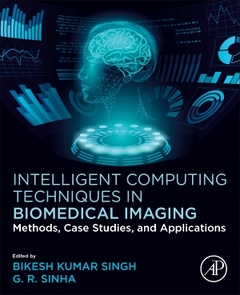Intelligent Computing Techniques in Biomedical Imaging Methods, Case Studies, and Applications
Coordonnateurs : Singh Bikesh Kumar, Sinha G. R.

1. Introduction to Intelligent Techniques and applications
2. Probability Theory
3. Statistical Learning
4. Medical imaging modalities and medical image Acquisition
5. Medical image processing
6. Extraction of medical image descriptor
7. Feature selection and Dimensionality Reduction Biomedical Imaging
Section II Intelligent techniques for Medical Image Analysis
8. Introduction to Biomedical image classification techniques
9. Computer aided diagnosis and performance evaluation in Radiology
10. Applications of Intelligent techniques in Biomedical Image Analysis
11. Multimodal Imaging
12. Ethical considerations in biomedical imaging research
Section III Modern Applications (Case studies)
13. Breast cancer detection and diagnosis
14. Brain tumour detection and diagnosis
15. Imaging in Neuro-developmental disorders
16. Intelligent diagnosis of Ocular Diseases and Intelligent Cardiovascular Imaging
17. Thyroid detection and Imaging Technologies in Dentistry
18. Intelligent Pulmonary imaging
19. Intelligent techniques for bone fracture detection
Dr. G R Sinha is a Professor at Myanmar Institute of Information Technology (MIIT) Mandalay, Myanmar.
To his credit are 255 research papers, book chapters, and books, including Analysis of Medical Modalities for Improved Diagnosis in Modern Healthcare, Biomedical Signal Processing for Healthcare Applications, Brain and Behavior Computing, and Data Science and Its Applications from Chapman and Hall/CRC Press, Advances in Biometrics from Springer, and Cognitive Informatics, Volumes 1 and 2, AI-Based Brain Computer Interfaces, and Data Deduplication Approaches from Elsevier Academic Press. He was Dean of Faculty and an Executive Council Member of CSVTU and has served as Distinguished Speaker in the field of Digital Image Processing for the Computer Society of India. His research interests include Applications of Machine Learning and Artificial Intelligence in Medical Image Analysis, Biomedical Signal Analysis, Computer Aided Diagnosis, Computer Vision, and Cognit
- Introduces Fourier theory and signal analysis tailored to applications in optical communications devices and systems
- Provides strong theoretical background, making it a ready resource for researchers and advanced students in optical communication and optical signal processing
- Starts from basic theory and then develops descriptions of useful applications
Date de parution : 09-2024
Ouvrage de 300 p.
19x23.4 cm
Thèmes d’Intelligent Computing Techniques in Biomedical Imaging :
Mots-clés :
Medical Imaging; Artificial Intelligence; Machine Learning; Deep Learning; Biomedical Imaging modalities; CT scan; MRI; X ray; Ultrasound; Positron Emission Tomography (PET); Ultrasound Elastography; Optical Coherence Tomography (OCT); Functional MRI; Hybrid Modalities Computer Aided Diagnosis; Breast Cancer Imaging; Brain Imaging; Neuro-developmental disorders; Pulmonary Imaging; Cardio-vascular Imaging; Multimodal Imaging



